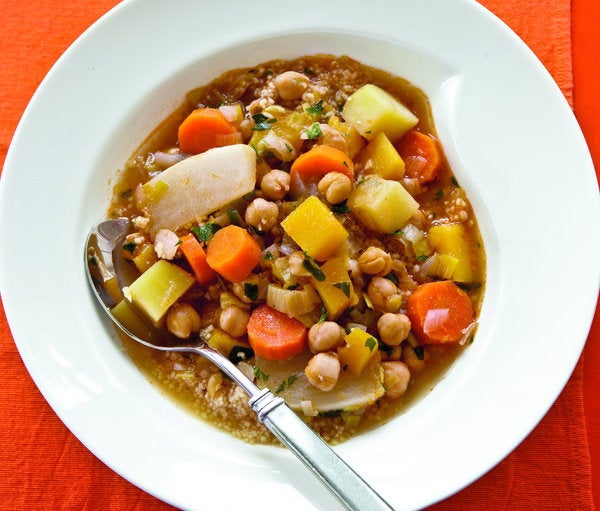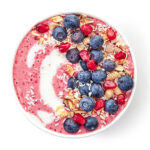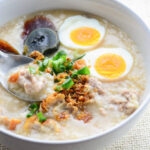Soya Chunks Chickpea Stew is a hearty and nutritious dish that combines the protein-rich goodness of soya chunks with the fiber-packed chickpeas in a flavorful stew. This stew is a delightful fusion of textures and flavors, offering a satisfying meal for vegetarians and meat-eaters alike. Typically seasoned with a variety of aromatic spices and herbs, Soya Chunks Chickpea Stew is not only delicious but also packed with essential nutrients, making it a wholesome option for a balanced diet. Whether enjoyed as a standalone meal or paired with rice or bread, this stew is sure to tantalize your taste buds and leave you feeling nourished and satisfied.
| Ingredients | |
| 1 | 1 cup dried soya chunks (textured vegetable protein) |
| 2 | 1 cup dried chickpeas (garbanzo beans), soaked overnight or canned chickpeas, drained |
| 3 | 2 tablespoons cooking oil (olive oil or vegetable oil) |
| 4 | 1 large onion, finely chopped |
| 5 | 3 cloves garlic, minced |
| 6 | 1-inch piece of ginger, grated |
| 7 | 2 tomatoes, chopped |
| 8 | 1 teaspoon ground cumin |
| 9 | 1 teaspoon ground coriander |
| 10 | 1 teaspoon paprika or chili powder (adjust to taste) |
| 11 | 1/2 teaspoon turmeric powder |
| 12 | Salt to taste |
| 13 | Black pepper to taste |
| 14 | 4 cups vegetable broth or water |
| 15 | Fresh cilantro leaves, chopped (for garnish) |
| 16 | Lemon wedges (for serving) |
Step-by-step cooking instruction of Soya Chunks Chickpea Stew:
Step-1 Prepare the Soya Chunks and Chickpeas:
- If using dried soya chunks, soak them in warm water for about 15-20 minutes or as per package instructions until they are soft. Squeeze out the excess water and set aside.
- To use dry chickpeas, soak them in lots of water for the entire night. Before using, drain and rinse the chickpeas. Drain and rinse canned chickpeas under cold water if using.
Step-2 Sauté Aromatics:
- In a big pot or Dutch oven, heat the cooking oil over medium heat. Add the chopped onions and sauté until they turn translucent, about 5 minutes.
- Add minced garlic and grated ginger, and cook for another 1-2 minutes until fragrant.
Step-3 Add Spices and Tomatoes:
- Stir in the ground cumin, ground coriander, paprika or chili powder, and turmeric powder. Cook the spices for about 1 minute until they release their aroma.
- Add the chopped tomatoes to the pot and cook until they soften and break down, about 5-7 minutes, stirring occasionally.
Step-4 Add Soya Chunks and Chickpeas: Add the soaked and squeezed soya chunks to the pot along with the drained chickpeas. Stir well to combine with the onion-tomato mixture.
Step-5 Pour in Broth/Water:
- Pour in the vegetable broth or water into the pot, ensuring that the soya chunks and chickpeas are fully submerged.
- Season with salt and black pepper according to your taste preference.
Step-6 Simmer the Stew: Bring the stew to a gentle boil, then reduce the heat to low. Cover the pot and let the stew simmer for about 20-25 minutes, allowing the flavors to meld together and the stew to thicken slightly.
Step-7 Adjust Seasoning and Serve:
- If necessary, taste the stew and adjust the seasoning. You can add more salt, pepper, or spices according to your taste.
- Once ready, ladle the Soya Chunks Chickpea Stew into serving bowls. Garnish with chopped cilantro leaves and serve hot with lemon wedges on the side.
Step-8 Enjoy: Serve the Soya Chunks Chickpea Stew as a standalone meal or with rice, quinoa, or crusty bread for a complete and satisfying dining experience. Enjoy the flavorsome and nutritious goodness of this comforting stew!
Nutritional values of Soya Chunks Chickpea Stew:
The nutritional values of Soya Chunks Chickpea Stew can vary depending on specific ingredients used and serving sizes. However, here’s a general overview of the nutritional benefits you can expect from a typical serving:
Nutritional Values (per serving, approximately 1 cup):
| 1 | Calories: Approximately 250-300 kcal |
| 2 | Protein: Around 15-20 grams |
| 3 | Carbohydrates: About 25-30 grams |
| 4 | Fat: 10-15 grams (mostly from cooking oil) |
| 5 | Fiber: 6-8 grams |
| 6 | Vitamins and Minerals: |
| Rich in B vitamins, particularly folate, and vitamin C from ingredients like chickpeas, onions, tomatoes, and spices. Good source of minerals such as iron, magnesium, phosphorus, and potassium, primarily from chickpeas and soya chunks.Contains essential amino acids from the combination of soya chunks and chickpeas, making it a complete protein source for vegetarians. | |
Background History of Soya Chunks Chickpea Stew
The history of Soya Chunks Chickpea Stew is rooted in the culinary traditions of various cultures that have embraced plant-based protein sources and hearty stews as staples in their diets. While there may not be a specific documented origin for this particular dish, we can explore the historical contexts of its key ingredients – soya chunks and chickpeas – to understand their significance and how they might have been combined to create this delicious stew.
Soya Chunks:
Origins: Soybeans have been cultivated for thousands of years, primarily in East Asia, where they originated. China is believed to be the birthplace of soy cultivation, with evidence of soybean domestication dating back to around 1100 BCE.
Culinary Adoption: Soybeans and soy-based products like tofu, tempeh, and soy milk have long been integral parts of Asian cuisines, particularly in China, Japan, Korea, and Indonesia. These soy-based foods are valued for their versatility, nutritional benefits, and affordability.
Global Spread: Over time, soy-based products gained popularity worldwide due to their high protein content, making them valuable components of vegetarian and vegan diets. Soya chunks, also known as textured vegetable protein (TVP) or soy meat, are made from defatted soy flour and have become widely available as a meat substitute in various cuisines around the globe.
Chickpeas:
Origins: Chickpeas, also known as garbanzo beans, have a long history of cultivation in the Mediterranean, Middle East, and South Asia. They are believed to have been first cultivated around 7500 years ago in the region of modern-day Turkey and Syria.
Culinary Adoption: Chickpeas have been a staple food in many cuisines, including Indian, Middle Eastern, and Mediterranean. They are valued for their versatility, nutty flavor, and nutritional richness.
Vegetarian Cuisine: Chickpeas have been a cornerstone of vegetarian diets for centuries, providing a significant source of plant-based protein and fiber. Dishes like hummus, falafel, and chickpea stews are celebrated for their taste and nutritional value.
Emergence of Soya Chunks Chickpea Stew:
Culinary Fusion: Given the widespread adoption of both soya chunks and chickpeas in various culinary traditions, it’s plausible that the idea of combining these two protein-rich ingredients in a stew emerged through culinary experimentation and fusion.
Vegetarian and Vegan Cuisine: As the demand for vegetarian and vegan options continues to rise globally, chefs and home cooks alike are exploring creative ways to incorporate plant-based proteins into their meals. Soya chunks and chickpeas offer a winning combination of flavor, texture, and nutrition, making them ideal candidates for a hearty stew.
Modern Adaptations: While there may not be a specific historical account of the origins of Soya Chunks Chickpea Stew, it is likely a modern creation inspired by the rich culinary traditions of cultures that have long appreciated the nutritional benefits of plant-based foods.
In summary, Soya Chunks Chickpea Stew represents a contemporary dish that celebrates the diverse culinary heritage of plant-based ingredients like soya chunks and chickpeas, offering a delicious and nutritious option for vegetarians, vegans, and anyone seeking flavorful meatless meals.
| Advantages of Soya Chunks Chickpea Stew | |
| 1 | High Nutritional Value: Soya chunks and chickpeas are both rich sources of plant-based protein, making this stew a nutritious option for vegetarians and vegans. It’s also packed with dietary fiber, vitamins, and minerals, contributing to overall health and well-being. |
| 2 | Versatile and Flavorful: Soya chunks and chickpeas absorb flavors well, making them versatile ingredients that can be seasoned according to personal taste preferences. The stew can be customized with various spices, herbs, and vegetables to create a flavorful and satisfying meal. |
| 3 | Satiety and Weight Management: The combination of protein and fiber in soya chunks and chickpeas helps promote feelings of fullness and satiety, which may aid in weight management and reduce overall calorie intake. |
| 4 | Economical and Accessible: Soya chunks and chickpeas are affordable and widely available ingredients, making this stew a budget-friendly option for individuals and families. |
| Suitable for Dietary Restrictions: Soya chunks and chickpeas are naturally gluten-free and suitable for individuals with gluten sensitivities or celiac disease. The stew can be easily adapted to accommodate various dietary preferences and restrictions, such as vegetarian, vegan, and dairy-free diets. |
| Disadvantages of Soya Chunks Chickpea Stew | |
| 1 | Flatulent Properties: Chickpeas contain oligosaccharides, a type of carbohydrate that can cause gas and bloating in some individuals. Soaking dried chickpeas before cooking and consuming them in moderation may help reduce this issue. |
| 2 | Potential Allergies: Soya chunks are derived from soybeans, which are one of the top allergens. Individuals with soy allergies should avoid consuming soya chunks or opt for alternative protein sources. |
| 3 | High Sodium Content: Depending on the broth or seasoning used, Soya Chunks Chickpea Stew may contain high levels of sodium, which can contribute to hypertension and other health issues when consumed in excess. Choosing low-sodium broth or preparing homemade broth can help mitigate this disadvantage. |
| 4 | Requires Preparation Time: Soya chunks and chickpeas typically require soaking before cooking, which adds extra preparation time to the cooking process. Using canned chickpeas or pre-soaked soya chunks can help reduce cooking time. |
| 5 | Potential Digestive Discomfort: Some individuals may experience digestive discomfort, such as bloating or gas, when consuming soya chunks and chickpeas, particularly if they have sensitive stomachs or digestive issues. |
Compare with Similar meal of Soya Chunks Chickpea Stew:
Similar meals to Soya Chunks Chickpea Stew can include dishes that feature a combination of protein-rich ingredients, vegetables, and flavorful spices. Here are some similar meals that share similarities with Soya Chunks Chickpea Stew:
| 1 | Lentil and Vegetable Stew: A hearty stew made with lentils, assorted vegetables such as carrots, potatoes, and tomatoes, seasoned with aromatic spices like cumin, coriander, and paprika. This stew offers a rich source of protein, fiber, and essential nutrients. |
| 2 | Black Bean and Quinoa Chili: A nutritious chili made with black beans, quinoa, bell peppers, onions, and tomatoes, seasoned with chili powder, cumin, and garlic. This dish is packed with plant-based protein, fiber, and complex carbohydrates. |
| 3 | Chickpea and Spinach Curry: A flavorful curry made with chickpeas, spinach, onions, and tomatoes, simmered in a creamy coconut milk-based sauce infused with spices like turmeric, cumin, and garam masala. This dish is both comforting and nutritious, offering a balance of protein and vegetables. |
| 4 | Tofu and Vegetable Stir-Fry: A quick and easy stir-fry dish made with tofu, assorted vegetables such as bell peppers, broccoli, and mushrooms, stir-fried in a savory sauce made with soy sauce, ginger, and garlic. This dish provides a protein-packed and veggie-rich meal option. |
| 5 | Vegetable and Bean Soup: A wholesome soup made with a variety of beans such as kidney beans, cannellini beans, and lentils, along with an assortment of vegetables like carrots, celery, and tomatoes, flavored with herbs and spices. This soup is filling, nutritious, and perfect for chilly days. |
| 6 | Chana Masala (Chickpea Curry): A classic Indian dish made with chickpeas cooked in a spiced tomato-based sauce, seasoned with ginger, garlic, onions, and a blend of aromatic spices such as garam masala, coriander, and cumin. This flavorful curry pairs well with rice or naan bread. |
| 7 | Soy Protein and Vegetable Casserole: A comforting casserole dish made with soy protein (textured vegetable protein or tofu), mixed vegetables, and a creamy sauce, baked until golden and bubbly. This dish offers a satisfying combination of protein and vegetables in a comforting baked format. |
Mostly questions asked about Soya Chunks Chickpea Stew
1: What are soya chunks?
A: Soya chunks, also known as textured vegetable protein (TVP), are defatted soy flour products made by extruding soy flour under high pressure and temperature to create a meat-like texture.
2: Are soya chunks healthy?
A: Yes, soya chunks are considered a healthy source of plant-based protein and contain essential nutrients such as iron, calcium, and vitamins. They are also low in fat and cholesterol-free.
3: How do you cook soya chunks?
A: Soya chunks are typically soaked in warm water for about 15-20 minutes to rehydrate them before cooking. After soaking, they can be added to curries, stews, stir-fries, or boiled and seasoned according to recipe requirements.
4: What are the benefits of chickpeas?
A: Chickpeas are rich in protein, fiber, vitamins, and minerals such as folate, iron, and manganese. They promote satiety, aid in digestion, and may help regulate blood sugar levels.
5: How do you cook dried chickpeas?
A: Dried chickpeas should be soaked in water overnight or for at least 6-8 hours to soften them before cooking. After soaking, they can be simmered in water or broth until tender, typically for about 1-1.5 hours.
6: Can I use canned chickpeas instead of dried chickpeas?
A: Yes, canned chickpeas can be used as a convenient alternative to dried chickpeas. Simply rinse and drain the canned chickpeas before adding them to the stew.
7: Is Soya Chunks Chickpea Stew vegan?
A: Yes, Soya Chunks Chickpea Stew is a vegan dish since it contains no animal products. It’s made entirely from plant-based ingredients like soya chunks, chickpeas, vegetables, and spices.
8: Can I freeze Soya Chunks Chickpea Stew?
A: Yes, Soya Chunks Chickpea Stew can be frozen for later consumption. Let the stew cool fully before putting it in freezer bags or airtight containers. It keeps for up to three months in the freezer.
9: What are some variations of Soya Chunks Chickpea Stew?
A: Variations of Soya Chunks Chickpea Stew can include adding additional vegetables such as carrots, potatoes, or spinach, or experimenting with different spices and herbs to customize the flavor according to personal preferences.
10: Is Soya Chunks Chickpea Stew gluten-free?
A: Yes, Soya Chunks Chickpea Stew is naturally gluten-free as long as gluten-free ingredients are used in the recipe, such as gluten-free vegetable broth or spices. It’s suitable for individuals with gluten sensitivities or celiac disease.







